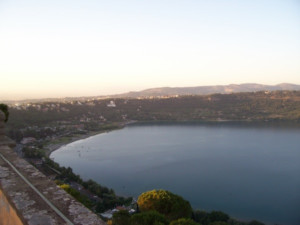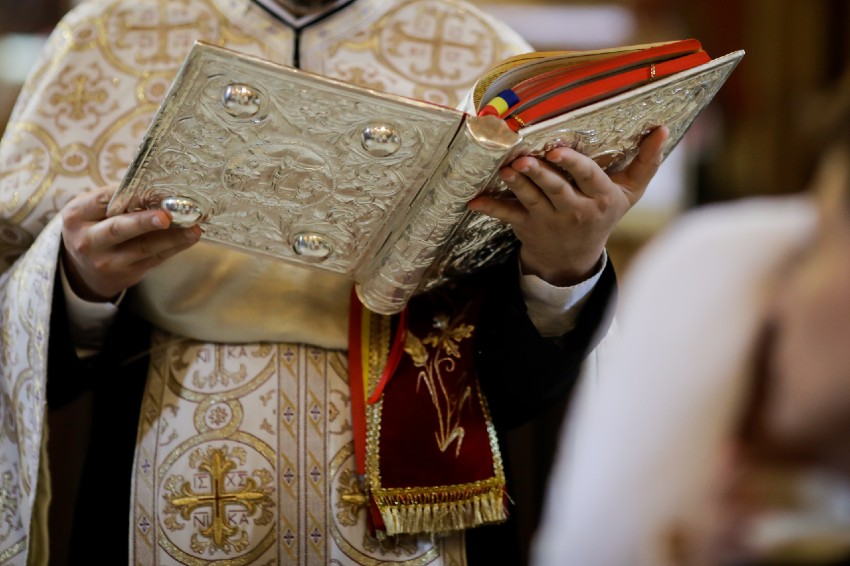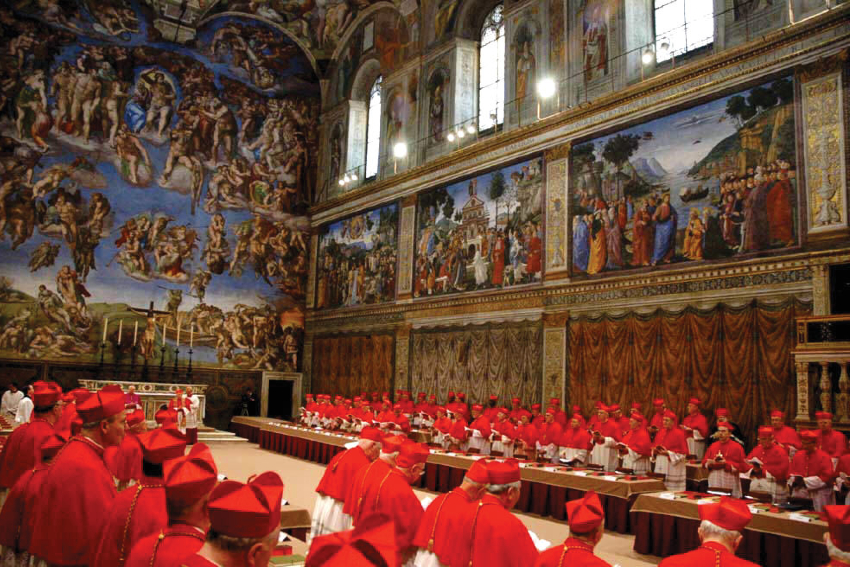On the Road
As the Pope rests in northern Italy after his fall, I am packing my bags for a journey. The strange patterns of providence…
By Robert Moynihan, reporting from Rome
 Rome this summer of 2009 has become quiet, especially in the past few days since the Pope went to northern Italy, and Claudio’s restaurant, La Vittoria, closed for a three-week summer vacation.
Rome this summer of 2009 has become quiet, especially in the past few days since the Pope went to northern Italy, and Claudio’s restaurant, La Vittoria, closed for a three-week summer vacation.
Around the Vatican, small crowds, or none. In the press office, no one. Empty.
The weather has been hot, but good, for weeks now. Tonight it was actually cool, not at all oppressively hot — amazing for this time of year…
In another week, Pope Benedict will return to Rome, and go out to Castel Gandolfo for most of August and September, where he will have views like this one from the roof of his palace, where I was on Thursday (I was able to visit the palace because one of my oldest friends in Rome is a Jesuit astronomer; see below).
In this letter, I wanted to thank those of you readers who are traveling along with me on this journey, and have sent messages of support and encouragement. I am, obviously, trying to find a new way to talk about Vatican and Church events. By mingling genres which are usually kept rigidly separated (letter writing and news reporting and personal meditation), I am taking a risk. Perhaps I will “get it wrong.” But perhaps (perhaps) I will get it more “right” than I could in any other way…
These last few weeks have been packed with historic events, and I will take the rest of the summer to reflect on — and discuss in our print publication, Inside the Vatican magazine — things like the Pope’s new encyclical and how relevant or not to our present economic crisis, his meeting with US President Barack Obama, and the attitude of the Vatican in general to the US and to the new American president.
Meanwhile, ever in the background, is the question of how the Pope is navigating his way through many challenges, both in governing the Vatican, and in preaching the Christian faith. I will try to explore these challenges in greater depth in upcoming reports, and in each issue of the magazine.
I remain concerned about Pope Benedict’s health.
About 10 years ago, my own father slipped and fell one evening, and none of us knew for sure whether he had slipped because he had fainted, or had had a minor stroke, or had simply slipped on a slippery spot. He himself couldn’t remember. He simply didn’t know.
The fact that the Vatican’s first press release after the Pope’s fall said it was a “light” fracture, and its second press release a few hours later said it was a “compound” fracture, and the fact that the Pope went in to tend to his wrist injury but then had a general CAT-scan — if I have understood the medical reports correctly — shows that there was a slow process of coming to understand the seriousness of his fall, then a real effort to discern whether it had serious causes.
I mentioned that I had the opportunity on Thursday to go out to Castel Gandolfo, the summer residence of the Pope for August and September, after he comes back to the Rome area form the Alps where he is now.
While out at the castle, I ran into a remarkable young Jesuit, Father David Brown, 28, from New Orleans. Brown, who has his Ph.D. in astronomy from Oxford, was about to head out to China for an astronomical meeting in Shanghai.
But as we talked, what I realized was that Brown had traveled on another, interior journey, which had taken him farther than his journey to Shanghai — farther even than his investigations of far galaxies.
I asked him why he had become a priest, and a Jesuit.
“The end of life, the goal of life, is a deep union with God,” Brown told me. “That is our great destiny: that we were created by love, by an act of love, to have life in love, with God.”
“But how did you come to this belief?” I asked. “So many young people today take a different path…”
“It was the Spiritual Exercises of St. Ignatius,” he said. “I wanted to know who I was, and what I wanted out of life — what I really, truly wanted — and I entered into the 30-day retreat with that purpose.
“And within a day and a half, I was digging down from my surface to my interior, from my superficial to my profound desires. And that went on, and on, and on, for 30 days. And I was changed…”
“What happened?” I asked.
“I came to understand what I really wanted. And what I really wanted was deep union with God, and to give glory to God, as best I can, in all that I say and do.”
And I was suddenly struck by the nobility, the audacity, the heroism, of this young man’s search, and it seemed to me that if a few more would undertake this same journey, here and there, that the Jesuit order might be renewed — that the Church might be renewed — that the world might be renewed.
So, those of you who feel called to do so, consider making an Ignatian retreat. It’s a journey that may change you forever.
And this young Jesuit’s spirituality has a deeply Marian dimension.
“The model for our humility, for breaking with the pride which keeps us from our true happiness, is Mary.” Brown said. “Mary was united with God. She bore God’s son. You cannot have a union that is deeper than that.
“Our belief, in the end, is that Mary was created the way we were all intended to be, the way every human being was meant to be. Mary was conceived without sin. This is not a statement about her divinity. Her sinlessness was not through any merit of her own. She was the first person redeemed by Christ. She who would conceive him needed to be a fitting vessel. And so, God prepared her to be that vessel…”
When I left Brown, I felt differently about the future of the Church.
I felt that, whatever crises we face — whatever “angels” and “demons” war over us — there is still the Holy Spirit, and the witness of so many saints who have gone before us… and are in our midst…
A Saint Who Went Before Us
Before I left the Specola, I had the chance to meet with Sabino Maffeo, S.J. (photo, with me), an 87-year-old Italian astronomer from near Naples who has the vigor of a 50-year-old, and the simplicity of a humble priest, though he is one of the world’s leading astronomers.
 He is the current director of the Vatican Observatory.
He is the current director of the Vatican Observatory.
In addition to authoring the book on the Specola which I mentioned yesterday (I included a photo of the cover, with the ray of sunlight striking the meridian line), Father Maffeo has just authored a book on one of the greatest Jesuit astronomers of the past century, Father Johann Georg Hagen, S.J. (photo below).
A century ago, Father Hagen was a world-renowned astronomer. He was the director of the Georgetown College Observatory in Washington D.C. before he was named the head of the Vatican Observatory in 1906.
But Hagen was also something else: he was the spiritual director of the foundress of the Roman and Swedish branch of the Bridgettine nuns, Blessed Elizabeth Hesselblad (1870-1957), a convert (photo below).
And what Father Maffeo has found is the correspondence of Father Hagen and Blessed Elizabeth.
I was struck by several of the letters.
One, written by Hagen to Hesselblad on July 21, 1903, when she was 33 years old, reads:
“How does God make his will known? First, the invitation to a life of perfection is very general and seems to apply to all who are naturally fit for it. ‘If thou wilt be perfect, sell what thou hast, give it to the poor, and come and follow me.’ Besides this general invitation, God’s Providence usually gives a special invitation; and this in three ways: 1) by a miraculous call, like that of St. Paul, St. Stanislaus, and others; 2) by interior consolations; 3) by quiet reasoning enlightened by the Holy Ghost. In these three cases, the spiritual advisor should only be the interpreter of the spirits, not the mover…”
A second, written by Father Hagen just after Elizabeth decides she will go to Rome from America, though she is often sickly, was sent on March 9, 1904:
“Indeed child, you are my child and my glory in this life, but especially in heaven… How strange God’s Providence was with you, how extraordinary your vocation! No wonder that a material eye like M’s could only see folly in it. It may be that God will soon take you to heaven; then you will admire his ways with you, leading you to such a holy place to die…”
Elizabeth was born in the village of Faglavik, Sweden, on June 4, 1870, the fifth of 13 children born to Augusto Roberto Hesselblad and Cajsa Pettesdotter Dag. The following month she was baptized and received into the Reformed Church of Sweden.
In 1886, in order to make a living and to support her family, she went to the United States of America. She went to nursing school at the Roosevelt hospital in New York and dedicated herself to home care of the sick.
Through prayer and personal study she was led to the Catholic Church and, on August 15, 1902, in the Convent of the Visitation in Washington, she received conditional baptism from Father Hagen, S.J.
Looking back on that moment of grace, she wrote:
“In an instant the love of God was poured over me. I understood that I could respond to that love only through sacrifice and a love prepared to suffer for His glory and for the Church. Without hesitation I offered Him my life, and my will to follow Him on the Way of the Cross.”
Two days later she received Communion, and then she left for Europe.
In Rome she received the Sacrament of Confirmation and she clearly perceived that she was to dedicate herself to the unity of Christians. She also visited the church and house of St. Bridget of Sweden (+ 1373), and came away with a deep and lasting impression, that she had heard a voice speaking to her these words: “It is in this place that I want you to serve me.”
She returned to the United States but, her poor health notwithstanding, she left everything and on March 25, 1904 she settled in Rome at the Casa di Santa Brigida, welcomed by the Carmelite Nuns who lived there.
In 1931 she experienced the great joy of receiving the Holy See’s permission to have permanent use of the church and house of St. Bridget in Rome.
Throughout her life she remained faithful to what she had written in 1904:
“Dear Lord, I do not ask to see the path. In darkness, in anguish and in fear, I will hang on tightly to your hand and I will close my eyes, so that you know how much trust I place in you, Spouse of my soul.”
Repeatedly to her daughters she said:
“We must nourish a great love for God and our neighbors; a strong love, an ardent love, a love that burns away imperfections, a love that gently bears an act of impatience, or a bitter word, a love that lets an inadvertence or act of neglect pass without comment, a love that lends itself readily to an act of charity.”
She died in April 1957. The reputation for holiness which surrounded her in life increased after her death, and almost immediately the Vicariate of Rome began the cause for her Beatification.
I have to shake my head at what seem to be the strange, inexplicable coincidences of life.
 Long before I ever imagined I would come to Rome, or write about the Vatican, a young Jesuit named Father Richard Boyle (in the photo at left, looking out from the room where the Vatican telescope is housed atop Castel Gandolfo, with the city of Rome at sunset in the distance) was giving retreats at a Jesuit retreat center in Gloucester, Massachusetts. This was in the 1970s.
Long before I ever imagined I would come to Rome, or write about the Vatican, a young Jesuit named Father Richard Boyle (in the photo at left, looking out from the room where the Vatican telescope is housed atop Castel Gandolfo, with the city of Rome at sunset in the distance) was giving retreats at a Jesuit retreat center in Gloucester, Massachusetts. This was in the 1970s.
I met Boyle in Gloucester in the mid-1970s, and then again in Rome, by pure chance, in the mid-1980s. By then he was a young Jesuit astronomer on the staff of the Vatican Observatory, and i, a young writer. And so, over the years, because of this strange quirk of destiny, I was able to go out to Castel Gandolfo and visit with him on many occasions.
I realize that it is a “small world,” but it still seems strange to me, that there can be meetings in our lives which seem accidental, which turn out, years or decades later, to have a meaning different or greater than we could at first have imagined.
I’ll be leaving Rome in a few hours. It’s 4:24 in the morning, (I have to be up at 7 to get ready to catch the plane at Fiumicino airport, and I have to return a book to a monsignor before I go…)
I’m packing my travel journal. I’ll check in from time to time, after I reach each of my destinations, to share with you what I have seen and heard, as the journey continues…
The following report, from Catholic News Service — which has three full-time, and very experienced, journalists covering the Vatican — gives information about the Pope’s Angelus message yesterday, and the state of his health: https://www.catholicnews.com/data/stories/cns/0903299.htm
Pope thanks doctors, well-wishers for treatment, prayers
 ROMANO CANAVESE, Italy, July 19, 2009 (CNS) — Pope Benedict XVI today thanked the doctors who treated his broken wrist and thanked everyone who prayed and expressed their concern for him…
ROMANO CANAVESE, Italy, July 19, 2009 (CNS) — Pope Benedict XVI today thanked the doctors who treated his broken wrist and thanked everyone who prayed and expressed their concern for him…
The Pope traveled about 50 miles by helicopter and car from Les Combes, where he has been vacationing, to Romano Canavese, the hometown of his Secretary of State, Cardinal Tarcisio Bertone.
“I especially want to thank the doctors and the medical staff who treated me with such diligence, compassion and friendship. As you can see, they were successful… we hope they were successful,” he said…
Doctors in Aosta told reporters the Pope was in good condition and that he would probably have to wear the cast for a month. He was released a few hours later July 17…
The swelling has gone down enough to allow him to put the papal fisherman’s ring back on his right hand…
Pope Benedict’s brief trip to Romano Canavese was designed to pay homage to his “closest collaborator,” Cardinal Bertone…
Cardinal Bertone told the Italian news agency ANSA that the broken wrist would make it difficult for the pope to use his Alpine vacation to continue work on the second volume of his book about Jesus.
The Vatican spokesman, Jesuit Father Federico Lombardi, said in a written statement that the Pope was “learning how to live with the right wrist in a cast.”
The most difficult thing for the Pope to get used to, the spokesman said, “is having to give up writing by hand, something he intended to do frequently” during his July 13-29 vacation.






Facebook Comments